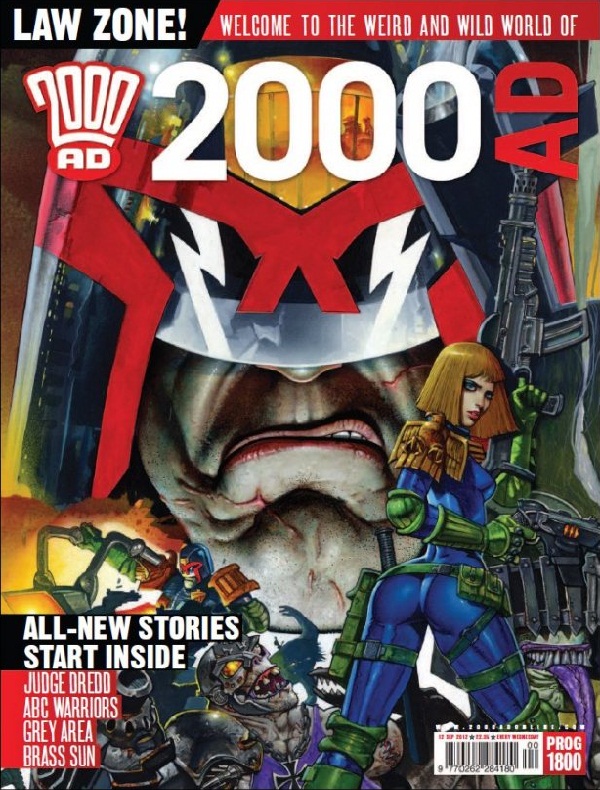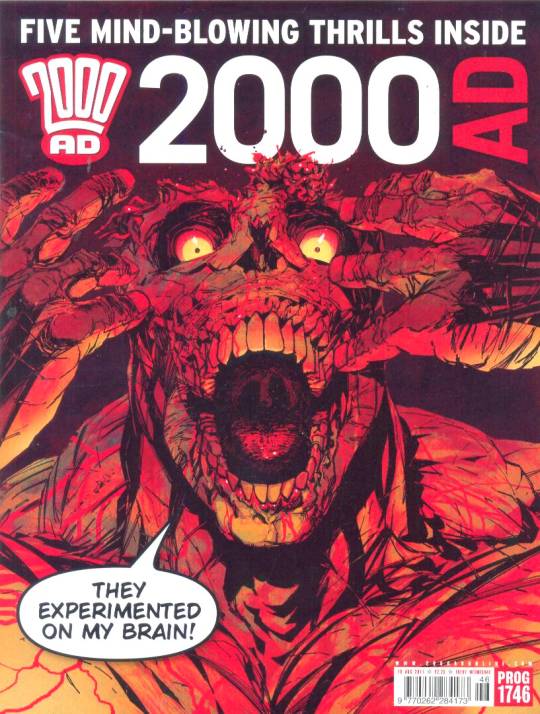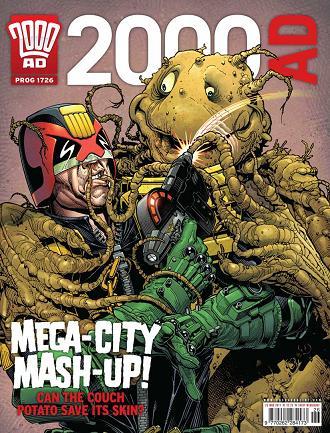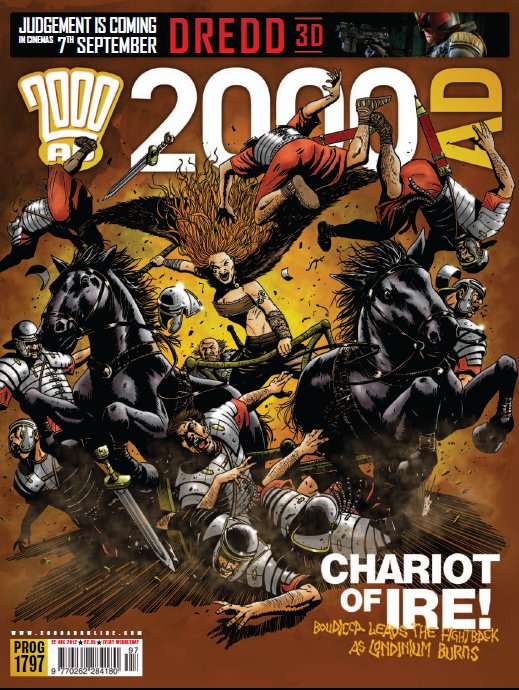Since 2002, Matt Smith has been the editor for 2000AD, the mostly-crazed British sci-fi anthology magazine which first appeared on shelves over 35 years ago. Since coming in as editor, he’s watched writers and artists like Frazer Irving, Si Spurrier, Jock, Henry Flint, Rob Williams and Leigh Gallagher take the book and continue to push their boundaries, making it one of the most inventive, manic titles on the shelves. Home to characters like Zombo, Judge Dredd, Ichabod Azrael and Harry Kipling, the book is distinctly British and bizarre — which means I’m fascinated by it.
How do you manage a title like 2000AD and bring it out every week, with four or five stories continuing at any one point? That’s a lot of people and characters to juggle at any one point in time, especially with the market being in flux right now. Desperate for knowledge, I contacted Matt and he agreed to answer some of my questions – despite being ill at the time. The British Spirit is Unstoppable!
Steve Morris: What was your start in comics as a whole? Were you a reader first? What stories first drew you in?
Matt Smith: I started reading comics from about 4 or 5 years old – I remember my mum buying me the first issue of Jackpot, a kids’ humour title. Then I read others like School Fun, started getting the 80s Eagle, then Scream, and finally 2000 AD in 1985. It was always Brit anthology comics – I didn’t read any US titles until I was about seventeen, and started getting into Hellblazer. I remember thinking from my first prog how harder-edged 2000 AD was compared to the likes of Eagle – Dredd and Strontium Dog were immediate favourites.
Steve: You started at 2000AD as editorial assistant to Andy Diggle. How did you come into the role?
Matt: It was advertised and I applied for it. I’d been working in book publishing prior to that as a desk editor.
Steve: How do you structure your role as editor? With a weekly shipping schedule, how far ahead do you have to plan to account for stories missing deadline, or other problems with scripting?
Matt: It depends on the length of the story – if it’s a 12 part series, it could be in development six months before it starts seeing publication, in which case there’s time to deal with any delays. You work backwards from when you need the last episode, and give the creator deadlines to hit each episode. But it’s always good to have back-up stories in place should something have to be pushed back.
Steve: Andy’s said before that he had a lot of ideas for where he wanted to move and progress the magazine. Was there a particular sense that you were both brushing away the cobwebs, in a way?
Matt: Well, Andy had a strong sense of what he did and didn’t like. I could appreciate his desire to instil more drama and energy into the comic.
Steve: In terms of business, what have been the main struggles for the magazine over the years? It’s distributed as a magazine, yet the content is a little more adult (well, way more) than other long-running British publications like The Beano. Does that ever hinder distribution?
Matt: The contents doesn’t hinder distribution. The main struggle is the ever-increasing cost of staying on the newsstand, plus rising print and distribution costs.
Steve: Would you even consider something like The Beano to be a rival, or are your main competitors American publishers like Marvel or DC?
Matt: No, they’re not rivals. We’re not fighting for the same readership.
Steve: 2000AD is a weekly anthology, which means you have weeks where every strip will be mid-story. Is the readership still fairly solid across the month, or do you have to plan for dips when there aren’t any stories to ‘jump in’ on? Do you even believe that readers need ‘jump on points’ every week?
Matt: I don’t think you need jumping on points every week – you’d never get a good head of steam up on a series if it kept changing week on week. To be honest, the readership numbers barely fluctuate between issues.
Steve: Has 2000AD’s readership aged over the past few decades, or have you found that new, younger readers keep coming onboard to the magazine?
Matt: Yes, the readership for the most part has aged alongside the mag. Average age is probably mid twenties to forties. Getting new readers is a continual quest, and something we plug away at with jumping-on issues, digital incentives, free comic-book day promos, etc. It would be nice to get younger readers but the National Literacy Trust issued a report recently showing that children are reading fewer novels, comics, magazines and websites. 50% of the 21,000 children and teenagers polled said they read comics, down from 64% in 2005. It’s a sector of the market you can chase but it’s diminishing.
Steve: You succeeded Andy as editor when he stepped down in 2002. Where do you think you’ve left your mark over the past decade?
Matt: I think maybe I looked to commission more new stories of varying styles (with varying degrees of success!). I’ve basically tried to establish a strong roster of characters – the same way Rogue Trooper, Strontium Dog and Nemesis the Warlock were the bedrock of the comic in the eighties – and alongside these experiment with a few more esoteric stories. I’m keen to keep the comic varied and surprising but stay true to its roots.
Steve: Creatively progressing the magazine over the years must be difficult, as many of the more popular characters happen, really, to be white, straight, males. There have absolutely been some moves towards a more diverse line-up – the current Aquila strip being a good example. But do you ever feel that 2000AD struggles to feature minority voices in the stories?
Matt: A character’s ethnicity or sexual orientation tends to come with the story, rather than a push to fill a quota. There was never a big deal made about Toy, a supporting character in Halo Jones, being gay, nor Devlin Waugh. Aquila’s ethnicity wasn’t a conscious push to make 2000 AD more diverse – it just suited the story.
Steve: Do you actively look for writers and artists who can offer different perspectives? How do you go about the process of finding new creative talent for the magazine?
Matt: Well, 2000 AD has an open submissions policy, but most of what comes through the door isn’t of publishable standard. I’m just looking for people that can write well, and convincingly. Having a unique voice helps too.
Steve: How do you deal with continuing strips like Judge Dredd, which don’t always feature the original creative team anymore? Do you have to run stories past John Wagner?
Matt: Dredd appears every week, so I need a constant flow of stories coming in. I don’t run them past John – I use my own judgement on whether they work, as Dredd’s a hard one to write. As editor, you need to have a good feel for the character.
Steve: What’s the mark of a good editor, overall? Should you dictate the tone, or should you let your creative talent go wild with their stories?
Matt: Edit with a light touch – it’s the creators people buy the comic for, not the editor, so it’s their work they want to read. But at the same time, you need to have a strong idea of what works in the comic and what doesn’t, and what’s suitable. And if necessary, you have to rein things in now and then.
Steve: Finally – what advice would you give people who are interested in working as an editor?
Matt: Get used to these four words: ‘I’ve got this idea…’











Matt has had an excellent effect on 2000AD. I genuinely feel the title is as strong now as any supposed ‘golden age.’
Here’s to another 10 years creep!
Nice to hear from the silent giant of British comics. 2000AD has hit a second golden age under Smith (no disrespect to past Thargs) and the comic has been a tower of strength for both US and UK talent. Frankly I only hope he’s there for 10 more years!
A good interview that shows how strong 2000 AD is at this current time. Great writers and artists under the ever watchful eye of Tharg. If they don’t keep up with his expected levels of Thrills, then it’s off to Mek-Quake!
Comments are closed.